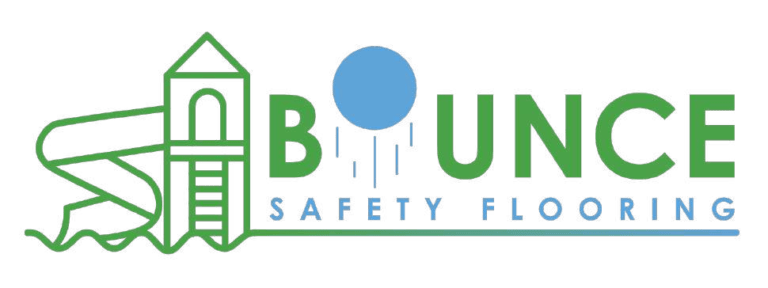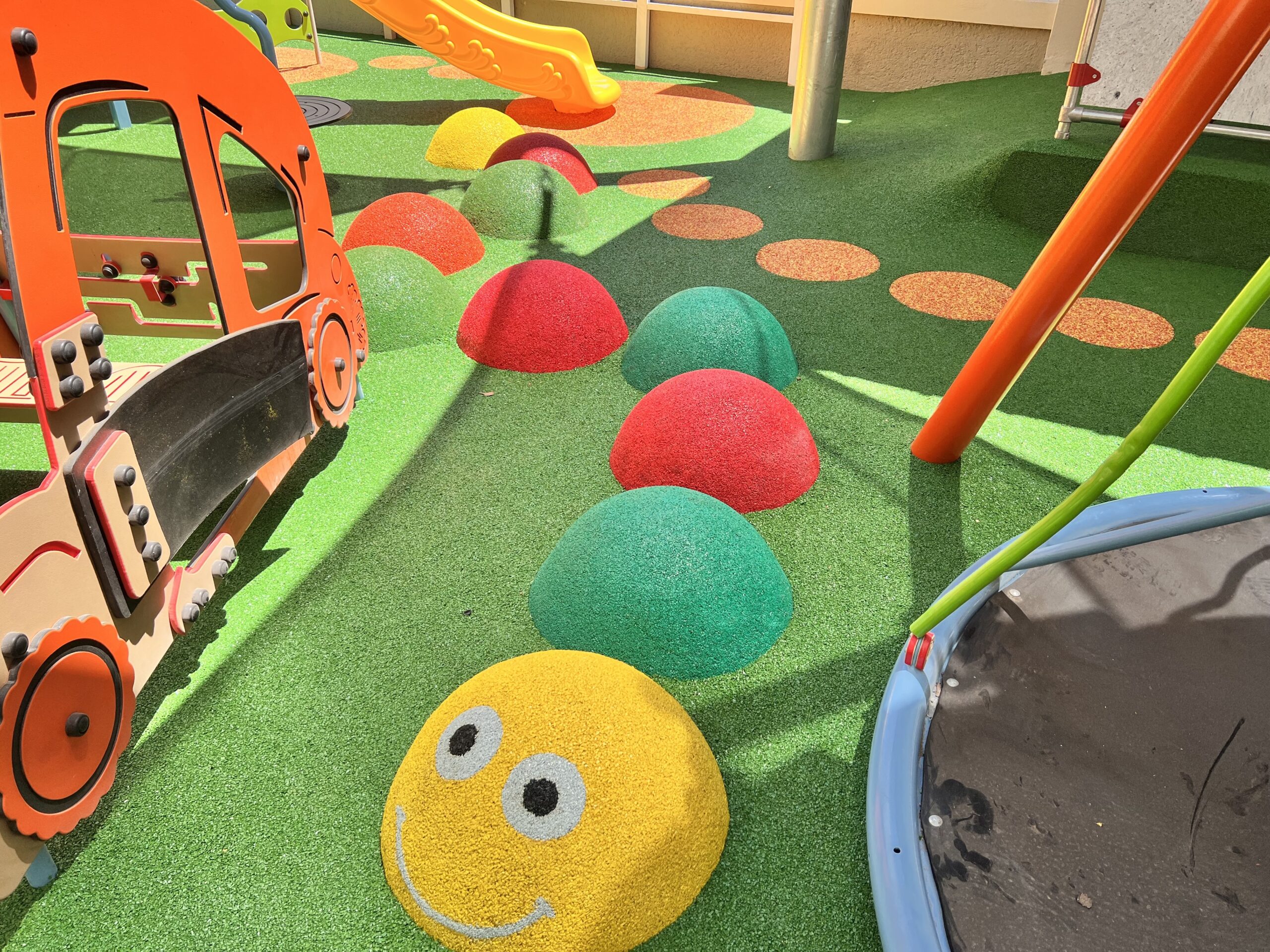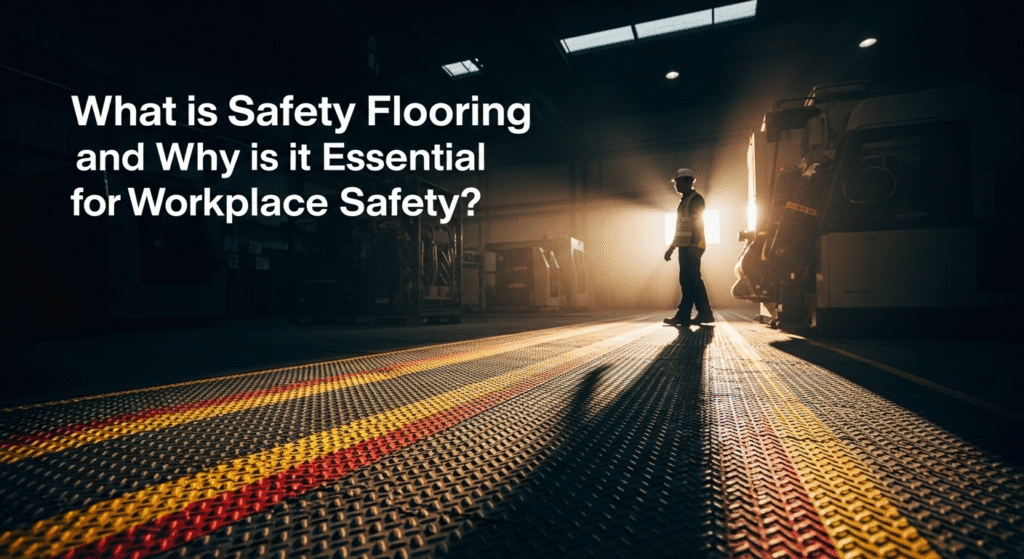This article provides a comprehensive guide on what is safety flooring, defining it as a specialised material engineered to prevent slips, trips, and falls through enhanced slip resistance. It covers how safety flooring achieves its protective function, explores different types and materials, distinguishes it from general non-slip treatments, and details measurement standards like R-value and Pendulum tests. The piece concludes by outlining critical factors for selecting the right safety flooring, emphasising its essential role in workplace safety, hygiene, and compliance for various commercial and institutional settings.
Safety flooring is a specialised type of flooring material designed with enhanced slip resistance to minimise the risk of slips, trips, and falls, particularly in environments prone to wetness, grease, or heavy foot traffic. Its importance is paramount in any commercial, industrial, or public setting where occupant safety is a primary concern, directly contributing to injury prevention, legal compliance, and operational continuity.
The inherent risks associated with unsafe flooring surfaces are often underestimated, leading to costly accidents, worker’s compensation claims, and potential legal ramifications. Understanding what is safety flooring and why it is essential empowers facility managers, restaurant owners, school administrators, construction contractors, and safety officers to make informed decisions that protect people and assets. This comprehensive guide delves into the specifics of safety flooring, its mechanisms, types, standards, and critical considerations for its selection and implementation.
How does safety flooring prevent slips, trips, and falls?
Safety flooring operates on several fundamental principles to significantly reduce the likelihood of slips, trips, and falls. Its primary mechanism is engineered slip resistance, achieved through a combination of material composition and surface design. Unlike standard flooring, safety flooring incorporates aggregates, textured surfaces, or specific chemical formulations to increase friction, even when wet or contaminated.
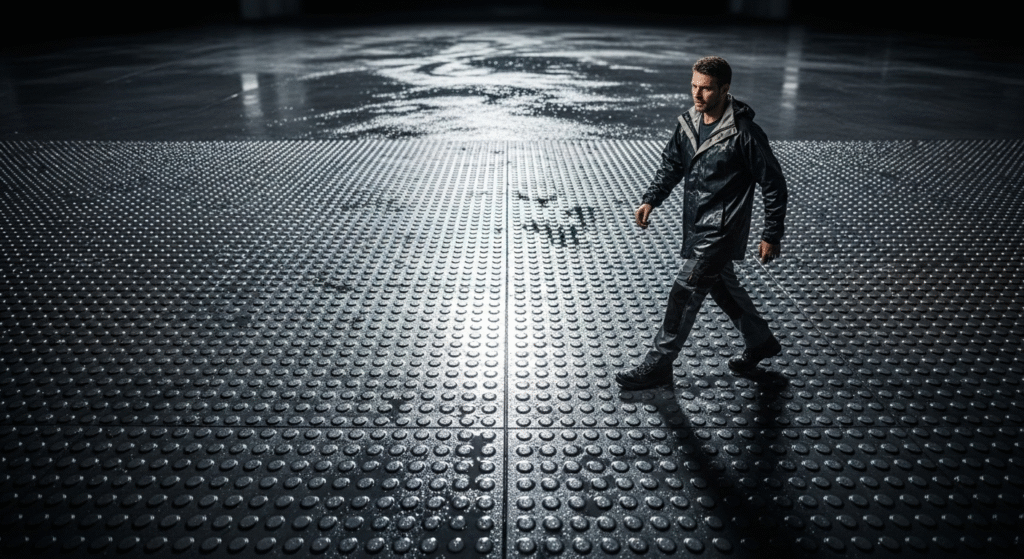
What are the key elements of slip resistance?
Slip resistance is primarily governed by the interaction between the shoe sole and the flooring surface. Safety flooring enhances this interaction through:
- Aggregates: Many safety flooring products embed hard particles (e.g., carborundum, quartz, aluminium oxide) into the wear layer. These aggregates create microscopic peaks and troughs, providing a gritty, abrasive surface that “bites” into the shoe sole, dramatically increasing friction.
- Surface Profile/Texture: Beyond aggregates, the physical texture of the flooring itself plays a critical role. Structured surfaces, often with embossed patterns or raised studs, help to displace water and other contaminants from beneath the foot, ensuring direct contact between the shoe and the high-friction surface.
- Material Composition: Certain materials, like rubber or specific vinyl compounds, inherently offer better grip than others. When combined with slip-resistant additives or surface treatments during manufacturing, their performance is further enhanced.
- Water Displacement Channels: Advanced safety flooring designs often include subtle channels or grooves that effectively disperse liquids away from the immediate point of contact. This prevents hydroplaning, where a thin film of liquid separates the foot from the floor, causing a loss of traction.
✅ Key Takeaway: Safety flooring is not merely “non-slip” on the surface; it is engineered from its core to provide sustained slip resistance, even under challenging operational conditions. This proactive approach significantly reduces accident potential.
What are the different types of slip-resistant flooring available?
The market offers a diverse range of slip-resistant flooring options, each suited to specific environments and hazard levels. The selection depends heavily on factors such as anticipated contaminants (water, oil, grease, chemicals), foot traffic volume, hygiene requirements, and aesthetic considerations. Understanding what is safety flooring in terms of its various manifestations is crucial for proper selection.
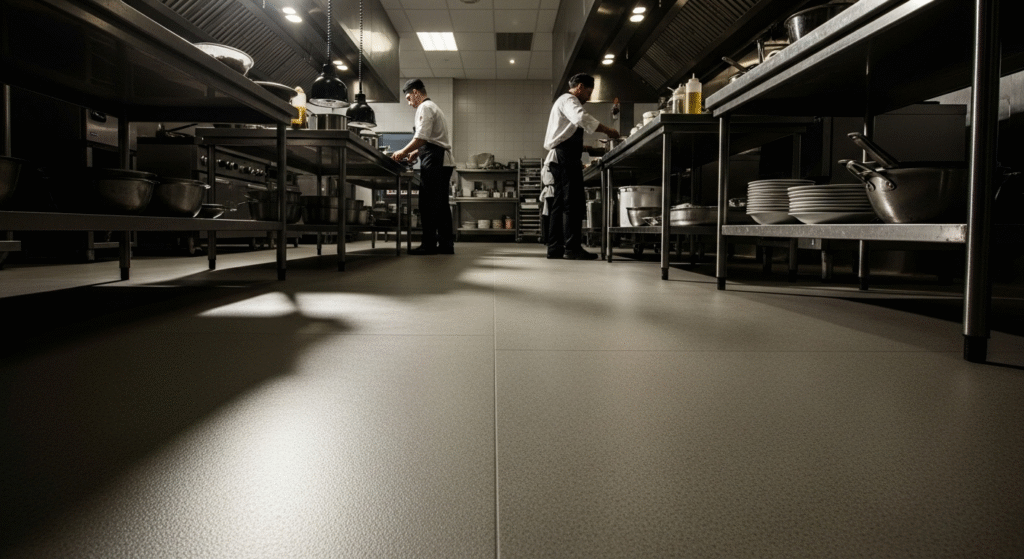
Here’s a breakdown of common types:
Types of Safety Flooring Materials and Their Applications
| Flooring Type | Primary Material | Key Features | Ideal Applications |
|---|---|---|---|
| Safety Vinyl | PVC (Polyvinyl Chloride) | Durable, hygienic, embedded aggregates, wide colour range | Commercial kitchens, hospitals, schools, laboratories, wet rooms, high-traffic corridors |
| Safety Rubber | Natural or Synthetic Rubber | Excellent grip, anti-fatigue properties, sound dampening | Gyms, playgrounds, industrial workshops, transport hubs, ramps, healthcare |
| Epoxy/Resin Flooring | Epoxy, Polyurethane, Methyl Methacrylate (MMA) | Seamless, highly chemical-resistant, can incorporate aggregates for custom slip rating | Heavy industry, food processing plants, manufacturing facilities, laboratories, car parks |
| Safety Tiles | Ceramic, Porcelain, Stone | Aggregates embedded, textured glaze, highly durable, aesthetic | Public restrooms, swimming pool surrounds, outdoor walkways, specific retail areas |
| Entrance Matting | Various fibres, rubber backing | Scrapes dirt/moisture, secondary line of defence | Building entrances, transition zones |
Which types of safety flooring are best for commercial kitchens?
Commercial kitchens require flooring that can withstand constant exposure to water, grease, oil, food debris, and high temperatures, while remaining aggressively slip-resistant. Safety vinyl and seamless resin systems (epoxy, polyurethane) are typically the preferred choices.
- Safety Vinyl: Specifically designed for kitchens, often with heavy-duty aggregates and bacteriostatic properties. Easy to clean and maintain hygiene.
- Resin Flooring (Epoxy/Polyurethane): Offers a seamless, impervious surface that is highly resistant to chemicals and thermal shock. Aggregates can be broadcast into the resin during application to achieve specific slip ratings.
What are the best options for healthcare facilities and schools?
Healthcare facilities and schools demand flooring that is not only slip-resistant but also extremely hygienic, durable, and easy to clean. Acoustic properties and patient/student comfort can also be factors.
- Safety Vinyl: Widely used for its excellent hygiene, ease of maintenance, and embedded slip resistance. It often comes with anti-bacterial properties crucial for clinical settings.
- Safety Rubber: Provides comfort underfoot, good sound absorption, and robust slip resistance, making it suitable for corridors, gyms, and activity areas where falls are a concern.
- Linoleum (with enhanced slip resistance): Natural, sustainable options exist that provide good slip resistance while meeting environmental and health standards.
What materials are typically used to manufacture safety flooring?
The effectiveness of safety flooring hinges significantly on the materials used in its construction. Manufacturers select and combine materials to achieve specific performance characteristics, balancing slip resistance with durability, hygiene, and aesthetic appeal.
Common Materials and Their Properties:
- Polyvinyl Chloride (PVC) / Vinyl: This is one of the most common base materials for safety flooring. High-grade PVC is combined with aggregates like carborundum or aluminium oxide, which are permanently embedded throughout the wear layer. This ensures that the slip-resistant properties remain effective even as the floor wears down over time. Vinyl is highly versatile, available in sheets or tiles, and can be coved up walls for seamless, hygienic installations.
- Rubber: Natural or synthetic rubber offers inherent slip resistance, particularly when embossed with textures like studs or diamond plates. It’s renowned for its durability, resilience, anti-fatigue properties, and sound absorption. Rubber flooring is ideal for areas requiring comfort, robust slip resistance, and impact absorption.
- Resins (Epoxy, Polyurethane, MMA): These are liquid-applied systems that cure to form a seamless, highly durable surface. Aggregates (e.g., quartz, silica sand) are broadcast into the wet resin during installation and then sealed with a clear topcoat. Resin floors are exceptionally strong, chemical-resistant, and can be customised for specific slip ratings and aesthetic requirements. They are often chosen for heavy industrial, pharmaceutical, and food processing environments.
- Ceramic and Porcelain with Aggregates: Traditional tiles can be engineered for slip resistance by incorporating abrasive particles into the glaze or body, or by creating a highly textured surface. These are common in public restrooms, swimming pool surrounds, and outdoor areas where extreme durability and weather resistance are required.
- Silica/Quartz Aggregates: These hard, mineral particles are the most common aggregates used to provide the ‘grit’ in safety flooring. They are highly durable and contribute significantly to the surface friction.
- Fibreglass/Polymer Composites: In some specialised applications, composite materials may be used to create extremely robust and lightweight safety flooring, often for grating or outdoor deck areas.
💡 Pro Tip: When evaluating safety flooring, always inquire about the depth and distribution of the slip-resistant aggregates. Materials where aggregates are embedded throughout the entire wear layer will maintain their performance longer than those with only a surface coating.
What is the difference between safety flooring and general non-slip treatments?
It’s crucial to distinguish between purpose-built safety flooring and general non-slip treatments, as their effectiveness, longevity, and suitability for high-risk areas vary significantly. Understanding what is safety flooring clarifies why it’s the preferred solution for sustained safety.
- Safety Flooring:
- Inherent Design: Safety flooring is engineered from the ground up with slip resistance as a core, integral feature. The slip-resistant properties (e.g., embedded aggregates, specific surface textures, material composition) are built into the material itself, often throughout the entire wear layer.
- Durability & Longevity: Due to its inherent design, safety flooring maintains its slip resistance over its entire lifespan, even with wear and tear. It is typically designed for heavy-duty use and provides a long-term solution.
- Compliance: Many safety flooring products are certified to meet rigorous international and local slip resistance standards (e.g., SANS standards in South Africa).
- Cost: Generally a higher initial investment due to advanced manufacturing and material quality.
- Application: A permanent installation, part of the building’s infrastructure.
- Example: Altro Contrax, Polyflor F2000, seamless resin floors with broadcast aggregates.
- General Non-Slip Treatments:
- Surface Application: These are typically coatings, tapes, mats, or chemical treatments applied to an existing floor surface to temporarily enhance grip.
- Temporary/Variable Durability: The effectiveness of non-slip treatments can degrade rapidly due to foot traffic, cleaning chemicals, and environmental factors. Tapes can peel, coatings can wear off, and chemical treatments may require frequent reapplication.
- Limited Compliance: While they can improve surface friction, they often do not meet the stringent, sustained performance requirements of certified safety flooring, especially in high-risk areas.
- Cost: Lower initial cost, but can incur significant recurring costs for reapplication or replacement.
- Application: Often a quick, short-term fix or a supplementary measure.
- Example: Anti-slip tapes, grit-added paint, chemical etching solutions, loose anti-fatigue mats.
Essentially, safety flooring offers a permanent, engineered solution, while non-slip treatments provide temporary or supplementary improvements. For critical areas with high slip potential, opting for purpose-built safety flooring is always the more reliable and responsible choice.
What makes safety flooring a better option than standard vinyl or linoleum in high-risk areas?
When considering flooring for areas prone to wetness, grease, or heavy foot traffic, the distinction between what is safety flooring and standard vinyl or linoleum becomes critically important. While standard vinyl and linoleum offer aesthetic appeal, durability, and ease of cleaning, they lack the specialised engineering required for high-risk environments.
Here’s why safety flooring surpasses standard options in critical areas:
- Superior Slip Resistance: This is the most significant differentiator. Standard vinyl and linoleum, while smooth and easy to clean, offer very limited slip resistance, especially when wet or contaminated. Safety flooring, with its embedded aggregates and textured surfaces, provides dramatically higher friction and grip under these conditions.
- Integrated Protection: The slip-resistant properties in safety flooring are an integral part of its construction, often extending through the entire wear layer. This means that as the floor ages and experiences wear, its safety characteristics remain largely intact. Standard flooring would become a significant hazard if subjected to the same conditions.
- Compliance with Standards: Safety flooring is rigorously tested and often certified to meet specific slip resistance standards (e.g., SANS, EN, DIN standards). This compliance is often a legal or insurance requirement for commercial and industrial spaces. Standard vinyl or linoleum rarely meet these stringent safety benchmarks.
- Enhanced Durability for Specific Hazards: Many safety flooring solutions are designed not just for slip resistance but also to withstand specific hazards prevalent in high-risk areas. For instance, commercial kitchen safety flooring is often resistant to oils, fats, acids, and thermal shock. Standard materials may degrade or become brittle under such exposure.
- Hygienic Design for Wet Environments: While standard vinyl and linoleum are easy to clean, some safety flooring products offer coved installations and seamless finishes specifically designed to prevent water ingress and bacterial growth, crucial for wet areas like ablution blocks or processing plants. [INTERNAL LINK: Consider linking “seamless finishes” to an article about “benefits of seamless hygienic flooring”].
- Reduced Liability and Risk: Investing in what is safety flooring significantly reduces the risk of accidents, which in turn minimises potential liability claims, lost workdays, and negative publicity. For a restaurant owner, school facilities manager, or safety officer, this translates directly into a safer, more compliant, and more productive environment.
In essence, while standard flooring excels in general purpose areas, safety flooring is a specialist solution for specialist risks. It’s a proactive investment in preventing accidents where the consequences of a slip, trip, or fall are severe.
How is the slip resistance of flooring materials measured and rated?
Accurate measurement and rating of slip resistance are fundamental to ensuring that safety flooring performs as expected and meets regulatory requirements. Various methodologies and standards exist globally, with South Africa often referencing SANS standards which align with international best practices.
Key Measurement Methods:
- Pendulum Test (Dynamic Coefficient of Friction – DCOF):
- Principle: A weighted pendulum with a rubber foot swings over a test surface. The distance the pendulum travels after making contact indicates the friction between the foot and the surface.
- Conditions: Can be conducted in both wet and dry conditions.
- Relevance: Widely used and recognised, particularly for assessing pedestrian slip resistance in real-world scenarios. A higher pendulum test value (PTV) indicates greater slip resistance.
- R-Value Test (Ramp Test – DIN 51130 and DIN 51097):
- Principle: A person wearing standard safety footwear walks forwards and backwards on a ramp covered with the test flooring. The angle of the ramp is gradually increased until the person slips.
- Conditions:
- DIN 51130: Performed with motor oil as a contaminant, assessing slip resistance in work areas with oily/greasy conditions. Results are categorised from R9 (lowest slip resistance for safety flooring) to R13 (highest).
- DIN 51097: Performed with water as a contaminant, assessing slip resistance in wet barefoot areas (e.g., swimming pools, showers). Results are categorised from A (lowest) to C (highest).
- Relevance: Excellent for simulating real-world working conditions and barefoot areas. The R-value is a direct, practical measure of slip resistance.
- Static Coefficient of Friction (SCOF):
- Principle: Measures the force required to get an object moving on a surface.
- Relevance: Historically used, but increasingly considered less reliable for predicting dynamic slips (where motion is already occurring). Most modern standards favour DCOF.
Understanding Slip Rating Scales:
| Test Method | Condition | Rating Scale | Interpretation |
|---|---|---|---|
| R-Value (DIN 51130) | Oily/Greasy (Footwear) | R9 to R13 | Higher R-value = greater slip resistance. R9 is minimum for general safety. |
| R-Value (DIN 51097) | Wet (Barefoot) | A, B, C | C offers the highest slip resistance for barefoot wet areas. |
| Pendulum Test | Wet/Dry (Footwear) | PTV (Pendulum Test Value) | PTV > 36 is generally considered a low slip risk. |
What are the relevant industry standards or certifications for safety flooring?
Adherence to industry standards and certifications is paramount in specifying and installing safety flooring. These standards provide a benchmark for performance, ensuring that products are fit-for-purpose and contribute effectively to risk reduction. For South Africa, the South African National Standards (SANS) play a critical role, often referencing or aligning with international norms.
Key Standards and Certifications:
- SANS 10070: This South African standard provides guidelines for the measurement of the slipperiness of pedestrian surfaces. It often references and adapts international testing methods like the Pendulum Test (BS EN 13036-4) and the Ramp Test (DIN 51130/51097). Compliance with SANS 10070 ensures that a flooring product has been tested and rated according to nationally recognised methodologies.
- BS EN (British Standards European Norms): Many flooring products available in South Africa are manufactured to or comply with BS EN standards. For slip resistance, key standards include:
- BS EN 13036-4: Specifies the method for measuring pedestrian slip resistance using the Pendulum Test.
- BS EN 13845: This is specifically for flexible PVC floor coverings with particle-based enhanced slip resistance. It covers requirements for dimensions, performance, and classification.
- DIN (Deutsches Institut für Normung – German Institute for Standardization): The DIN standards for ramp testing (DIN 51130 for oil-wet areas and DIN 51097 for barefoot wet areas) are globally recognised benchmarks for slip resistance and are frequently cited by manufacturers.
- ISO (International Organization for Standardization): While ISO doesn’t directly certify individual flooring products for slip resistance, it provides frameworks and guidelines for quality management (ISO 9001) and environmental management (ISO 14001), which can indirectly attest to a manufacturer’s commitment to quality and responsible production.
- HACCP (Hazard Analysis and Critical Control Points): For food preparation areas (like commercial kitchens), flooring needs to be compatible with HACCP principles. While not a direct slip resistance standard, HACCP compliance implies the flooring must be hygienic, easy to clean, and contribute to overall food safety, which often includes slip-resistant properties to prevent accidents in wet/greasy conditions.
- Local Building Codes and Regulations: Beyond specific flooring standards, local building codes and occupational health and safety regulations (e.g., the Occupational Health and Safety Act in South Africa) mandate safe working environments, which inherently includes the requirement for appropriate flooring to prevent slips and falls.=
A Construction Contractor looking for compliant flooring specs will specifically seek products with verifiable R-values or PTVs that meet the SANS 10070 guidelines for their project’s intended use. A Safety Officer will demand certified safety flooring data to demonstrate workplace risk reduction.
Is safety flooring waterproof, water-resistant, or suitable for wet areas?
The terms “waterproof” and “water-resistant” are often used interchangeably, but they have distinct meanings, especially when discussing what is safety flooring and its suitability for wet environments. Understanding these distinctions is crucial for proper specification and performance.
- Water-Resistant: This implies the material can withstand exposure to water without being significantly damaged or losing its functional properties for a certain period. Most high-quality safety vinyls and rubber flooring are water-resistant. They won’t immediately absorb water or swell, but prolonged saturation or standing water can eventually compromise adhesives or seams.
- Waterproof: This means the material is impervious to water, preventing its passage completely. While few flooring materials are inherently 100% waterproof on their own, a flooring system can be made waterproof through specific installation techniques. Seamless resin floors, when properly installed and cured, can be considered truly waterproof.
- Suitable for Wet Areas: This is the practical classification for safety flooring. A floor is considered “suitable for wet areas” if it offers sustained slip resistance in the presence of water (and other contaminants) AND can be installed in a manner that prevents water penetration beneath the surface or into the subfloor.
How is suitability for wet areas achieved?
- Material Selection: Choosing materials like safety vinyl, rubber, or resin that are inherently non-porous or have very low absorbency.
- Seamless Installation: For sheet goods (like safety vinyl or rubber), hot-welded seams create a continuous, impermeable surface, preventing water from seeping through joints. For resin systems, the liquid application inherently creates a seamless finish.
- Coving: Extending the flooring material up the wall (coving) creates a seamless, watertight transition from floor to wall. This is critical in areas requiring frequent wash-downs, like commercial kitchens or hospital operating theatres.
- Integrated Drainage: In areas with significant water, the flooring system must be integrated with appropriate drainage solutions (e.g., floor drains, channel drains) to ensure water does not accumulate.
For a Restaurant Owner dealing with staff slipping in a wet kitchen, safety flooring that is not only slip-resistant but also forms a seamless, hygienic, and effectively “waterproof” system via coving and welded seams is essential. Similarly, for a School Facilities Manager needing durable, low-maintenance floors in bathrooms or changing rooms, selecting products specifically rated for wet areas with proper installation is key.
What factors should be considered when choosing the right safety flooring for a specific area?
Selecting the appropriate safety flooring is a critical decision that impacts safety, hygiene, durability, and operational costs. It requires a comprehensive assessment of the environment’s specific needs, hazards, and regulatory requirements. Understanding what is safety flooring for your particular application involves weighing several interconnected factors.
How do you assess foot traffic and potential contaminants?
- Foot Traffic Volume:
- Low Traffic: Areas like storage rooms or seldom-used corridors may require less aggressive slip resistance.
- Medium Traffic: General office areas, waiting rooms, or classrooms need reliable, general-purpose slip resistance.
- High Traffic: Entrances, main corridors, retail aisles, and public spaces demand highly durable, high-performance safety flooring that maintains its grip over time.
- Heavy Industrial Traffic: Areas with forklifts, heavy machinery, or intense foot traffic require extremely robust, often resin-based, solutions.
- Anticipated Contaminants:
- Water: Bathrooms, changing rooms, swimming pool surrounds, and outdoor walkways require excellent wet slip resistance.
- Grease/Oil/Food Debris: Commercial kitchens, food processing plants, and automotive workshops need flooring with high R-values (R11-R13) to prevent slips on oily substances.
- Chemicals: Laboratories, manufacturing plants, and healthcare facilities require chemical-resistant safety flooring that won’t degrade or become slippery when exposed to spills.
- Dust/Fine Powders: Certain industrial settings may have dry contaminants that still pose a slip risk; the flooring must be easy to clean.
What are the hygiene and cleaning requirements?
- Ease of Cleaning: The texture of safety flooring, while vital for grip, should not make cleaning excessively difficult. Consider smooth-textured safety vinyls for less aggressive environments, or seamless resin systems that prevent dirt and bacteria from harbouring in grout lines.
- Sanitation: In healthcare, food preparation, and pharmaceutical environments, flooring must be non-porous and resistant to bacteria and fungi. Coved installations and hot-welded seams minimise crevices where pathogens can thrive.
- Cleaning Regimen: The type of cleaning (e.g., scrubbing, pressure washing, chemical cleaning) should influence material choice. Some safety floors are designed to withstand aggressive cleaning protocols.
How important are aesthetics and long-term cost?
- Aesthetics: While safety is paramount, the appearance of the flooring can be important, especially in public-facing areas like retail, schools, or healthcare reception areas. Modern safety flooring comes in a wide array of colours, patterns, and finishes that can complement interior design without compromising safety.
- Long-Term Cost (Life Cycle Costing):
- Initial Investment: Safety flooring often has a higher upfront cost than standard alternatives.
- Durability: High-quality safety flooring is designed for longevity, reducing replacement frequency.
- Maintenance: Consider the ongoing costs of cleaning, repairs, and the specific cleaning agents required.
- Safety Benefits: Factor in the savings from reduced accidents, lower insurance premiums, and fewer injury claims. The “cost” of an accident (medical bills, lost productivity, legal fees) far outweighs the investment in proper safety flooring.
- Compliance: Avoid potential fines or legal action for non-compliance.
💬 Expert Insight:
“Choosing the right safety flooring is a critical investment in your facility’s operational safety and long-term viability. It’s not just about compliance; it’s about protecting your people and your business from preventable accidents and ensuring a clean, efficient working environment.”
Consider the diverse needs of the target audience:
- Restaurant Owner: Needs hygienic, slip-resistant flooring for wet/greasy kitchens, prioritising safety vinyl or seamless resin.
- School Facilities Manager: Seeks durable, low-maintenance, slip-resistant options for corridors, classrooms, and wet areas, likely considering safety vinyl or rubber.
- Construction Contractor: Requires detailed specs (R-value, SANS compliance) to meet project requirements and regulatory standards.
- Safety Officer: Focuses on certified slip data and comprehensive risk reduction, seeking transparent product information and compliance documentation.
All these considerations culminate in the selection of what is safety flooring that is not only effective in preventing slips, trips, and falls but also practical, durable, and cost-effective over its lifespan.
Frequently Asked Questions
Q: Does safety flooring require special cleaning methods? A: While safety flooring is designed for durability and hygiene, its textured surface often requires specific cleaning methods and equipment (e.g., rotary scrubbers, specific brush types) to ensure deep cleaning and to maintain its slip-resistant properties. Harsh chemicals or improper techniques can degrade performance or damage the surface. Always follow the manufacturer’s guidelines.
Q: Can safety flooring be installed over existing floors? A: In many cases, yes, but it depends on the condition and type of the existing subfloor. The subfloor must be clean, dry, level, structurally sound, and free from contaminants. Often, preparation work such as levelling compounds or moisture barriers is required to ensure proper adhesion and performance of the new safety flooring.
Q: How long does safety flooring last? A: The lifespan of safety flooring varies significantly based on the material, quality, traffic levels, maintenance, and environmental conditions. High-quality safety vinyls and rubber can last 15-20 years or more in appropriate settings, while robust resin systems can exceed 20 years. Regular maintenance and proper use are key to maximising its lifespan.
The importance of safety flooring cannot be overstated. It is a fundamental component of any robust health and safety strategy, playing a vital role in preventing slips, trips, and falls—the leading cause of workplace injuries. By understanding what is safety flooring, its diverse types, rigorous testing standards, and critical selection factors, businesses and institutions can create safer, more compliant, and ultimately more productive environments. Investing in the right safety flooring is not just a regulatory obligation; it is a tangible commitment to the well-being of occupants and the longevity of your operations.
Secure your premises and protect your people. Contact a flooring specialist today to request a comprehensive flooring assessment or get a commercial kitchen flooring quote tailored to your specific needs.
